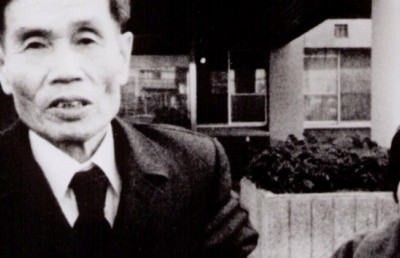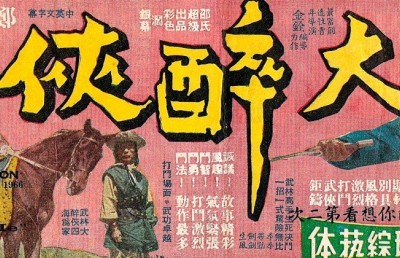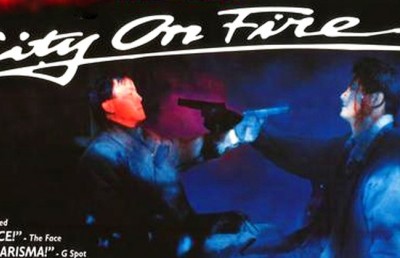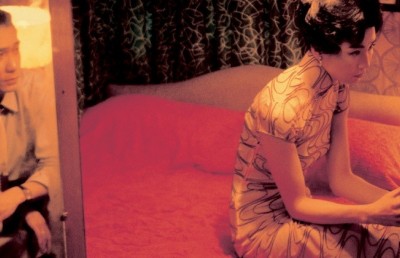Fantasia Special: 1999 & 2000
Looking Backwards & Forwards
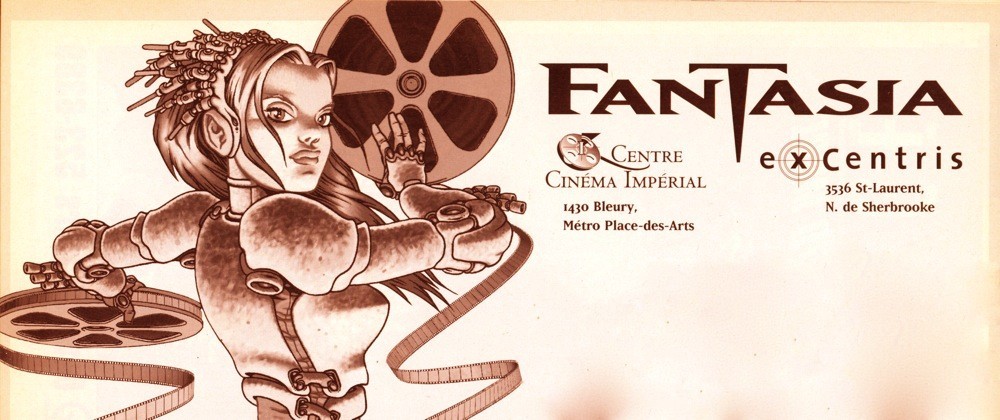
The best-laid plans often go awry. Which is why I am writing my Fantasia report for 1999 at the beginning Fantasia’s entry into the 21st century. In the following pages I will offer my thoughts on the films and personalities of note for Fantasia 1999, and preview what we can expect for Fantasia installment 2000 (www.fantasiafest.com). As someone who has been keeping a close eye on the festival since its smashing appearance on the Montreal festival circuit in 1996, it seems premature to be talking about a fifth anniversary. It seems only yesterday that organisers and cinephiles were staring with mouth agape at the tremendous queues encircling Bleury and St. Catherine (a corner I dubbed “Chan-ville” in 1996 because every film starring Jackie Chan scored an instant sell-out crowd).
One thing is certain, the Fantasia festival, headed by its amicable president Pierre Corbeil, team of program directors (Mitch Davis, Karim Hussain, Julien Fonfrède, Anthony Timpone), and programmers (André Dubois, Mi-Jeong Lee, Hiromi Aihara, Martin Sauvageau, Pascal Grenier, Mario Boivin) is not one to rest on its laurels. The festival is always progressing and is not afraid to make changes, a quality which will keep it from becoming stagnant and help sustain itself in a volatile (and in Montreal, extremely competitive) free market economy. For example, last year Fantasia decided to split itself, adding the recently opened, technologically sophisticated Ex-Centris as a second venue to the old standby, the Imperial Theatre. Top-notch viewing facilities notwithstanding, the experiment was a failure. One might think that the neo-modernist and architecturally adventurous Ex-Centris would have made a nice fit with the technologically sophisticated and stylistically adventurous Fantasia material. But in fact the atmosphere, diametrically opposed to the laid back Imperial, did not prove conducive to the post-film banter and hanging about that makes Fantasia so special. Whereas The Imperial Theatre is completely turned over to Fantasia, at the Ex-Centris it felt like rented space. At The Imperial Fantasia is the whole show. At the Ex-Centris Fantasia was merely one event among a plethora surrounding a bustling nighttime St.Laurent street. It is also comforting to know that if you are late or miss the films but want to catch up on the post-film socialising, there are only two places nearby to search out. Whereas outside the Ex-Centris there is bar after bar.
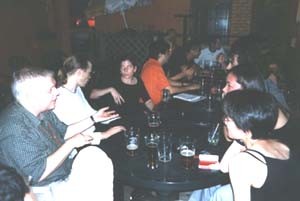
Fantasia crowd at Luba Bar
The good thing is that Fantasia is not afraid to admit a failure (witness the Toronto Fantasia spin-off that was a bust two years ago). So this year Fantasia is back to its singular Imperial location. But changes have been made elsewhere. Mainly with its decision to go partners with the very successful Just For Laughs comedy festival, and to concentrate on North American or Canadian premieres and new films, and cutting back on retrospective films. Frankly, this latter move is not to my liking, but I can see how it makes business sense, since the new films sell-out far more frequently than the retrospective offerings. Last year there was over 20 retrospective films, while this year the number is under 10. As I said, this makes perfect business sense, but I’ll regret the opportunity of viewing such films as Man Behind the Sun, The Untold Story, The Black Cat, In a Glass Cage, Kids from Shaolin, Schramm, School of the Holy Beast, The Beyond, Massacre at Central High, or Female Convict Scorpion on a big screen with a large audience!
On to the films. Every festival that throws together nearly 100 or so films will have some form of happenstance running theme. For Fantasia 1998 I noted the recurring theme/plot of torture. Based on advance information, torture seems to be making a comeback in 2000, with women meting out the pain and mutilation rather than men (Audition, Ring 0: The Birthday, The Black House, Freeze Me). But the major current buzzing through Fantasia 1999 was the theme or concept of hypnosis/mind control. Much of this is due to the stunning success of Japan’s reigning horror export, the Ring series (read Fangoria #193 for my feature piece on the Ring Phenomena, “Ring in the New Fear,” and the Hideo Nakata interview (The “Ring” Master). Ring was one of, if not the, highlight of Fantasia 1999. In many ways Ring is an old-fashioned style horror movie, with deliberate pacing, character development, and a slowly unfolding narrative puzzle. The film opens with a Scream-style scene of two girls home alone telling each other an urban myth about a girl who watched a video tape and then received a phone call telling her she would die a week later (she did). A divorced, single mother journalist becomes intrigued by the strange cult murders and begins, a la Evil Dead Trap, to investigate them. She comes across the video at a motel where the last murders occurred. Her curiosity (or is it fate?) gets the best of her and she watches the video: a grainy, creepy series of abstract images in a wooded area; a group of people crawling backwards along the ground (later we find out they are volcano victims); and an ominous well jutting out of the ground, just waiting for something suitably ‘unnamable’ to come crawling out. The images are prefixed by the words “Eruption” and “Sada.” Reiko shows the tape to her ex-husband, a mathematics teacher with his own special (Millenium-like) powers of seeing the past. When he becomes ‘infected’ by the video curse he joins Reiko in the quest to unravel the origins of the tape and its curse. Here the film takes a giallo-like journey with the heroic duo researching and visiting the site, and speaking to people with knowledge of the original event. They piece together that the cassette (from hell?) is governed by the scorned spirit of Sadako, a young Eastern female equivalent of Freddie. Sadako is the illegitimate daughter of a doctor seen in one of the film’s several black & white flashbacks. We see the doctor push Sadako into the well, the same well pictured in the cursed video, giving Sadako something to be very vindictive and mean spirited about.
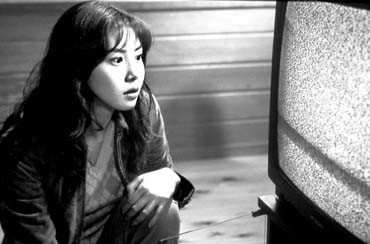
The Ring
Director Nakata and writer Hiroshi Takahashi returned for the sequel, Ring 2, and manage to maintain the original’s essence, while taking it along more conventional lines. Interestingly, I noted overtones of The Exorcist and its sequel, The Heretic, in Ring 2. In the end, the central male character asks his son to transfer his fear onto him, similar to the way Father Karras tells the demon to leave Regan’s body for his. The sequel’s decision to concentrate the plot on the relationship between doctor/subject and the mix of paranormal technology and esoteric philosophy seems clearly lifted from John Boorman’s own deviations from The Exorcist for The Heretic. My hypothesis proved correct when I mentioned this to Nakata at a post-screening social and he admitted that writer Takahashi was inspired by The Heretic. Fantasia also presented The Korean remake Ring Virus which is, unfortunately, a pale imitation of the original. It reverts to the novel, but the same scenes not in the novel are lifted from Nakata’s Ring. It sorely lacks Nakata’s attention to detail at every level, especially the soundtrack that was so instrumental in achieving Ring‘s horrific techno-natural atmosphere. Only the final scene of the vindictive ghost Sadako returning holds some punch. Fantasia 2000 continues with the third installment of the series, Ring 0: The Birthday, which is scripted by Takahashi but directed by Norio Tsuruta (no stranger to the genre, with the horror film Toneriko (1995) to his credit). Ring 0 is a natural prequel, taking us back 30 years into the past to fill in the snippets of Sadako’s life history that we are given in the brief flashbacks.
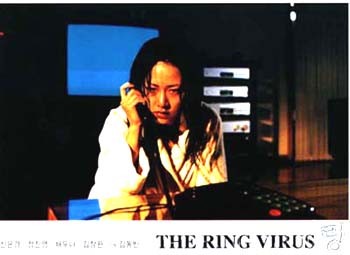
Pale Imitation: The Ring Virus
Two other films employing the theme of mind control were Kiyoshi Kurosawa’s Cure and Masayuki Ochiai’s aptly titled Hypnosis. One could point to the overwhelming success of the Ring series as a direct cause of this theme’s popularity, but Cure was made a year before Ring. Art very often mirrors society, and in this case we can see the lingering specter of the Japanese Aum cult (and others) having its effect on the Japanese psyche. However, both Cure and Hypnosis are original in their approach to this subject. Cure, arguably more stylistically adventurous than Ring, takes the theme along arthouse lines with its quiet, understated approach and pseudo-existentialism (the low-key serial killer asks his would-be victims the same question, “Who are you?”). Hypnosis takes an altogether different tact, opting for frenetic pacing (the editing at times being near experimental) and gruesome, over-the-top deaths. Victims are willed to suicide by a mind-controlling serial killer, and director Ochiai clearly has fun imagining ludicrous suicide scenarios (an athlete runs so hard she fractures her legs; an old man throws himself through a plate glass window; a man rams his forehead into a spike; a groom hangs himself with his tie, etc.).
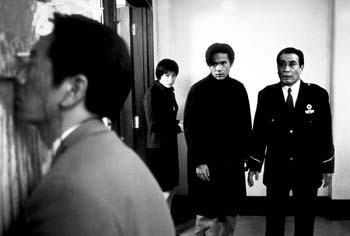
Hypnosis
Torture, too popular a theme in Fantasia 1998 to be passed up entirely, returned in 1999 in the form of masochism and sado-masochism in such films as Divided Into Zero (1999), In a Glass Cage (1986), Bullet Ballet (1998), The Black Cat (1934), Doctor Lamb (1992), Joys of Torture (1968), Kichiku (1997), Mark of the Devil (1969), Schramm (1993), School of the Holy Beast (1974), and Wife to be Sacrificed (1974). Divided Into Zero is a 31-minute short by Festival Program Director Mitch Davis that began three-and-a-half years ago. As I wrote in the Fantasia 1999 catalogue, Divided Into Zero is a harrowing dissection of a trauma-induced life. Told in memory flashes, the main character’s tortured life is splintered across different ages: as a boy, a young man, and an old man. The protagonist’s life is literally and metaphorically “scarred” at inception when, we are told by our aged narrator, he was cut on the thigh during cesarean birth. This primal moment is reflected through the film’s expressive use of primary colors and the characters bouts with scarification. Compounded by familial tragedy, the character descends into a personal hell of isolation, body mutilation, pedophilia, and murder. In a poetic subjective voice-over we are told, “There is a crack in the center of me.” Through this crack pours forth manifestations of irreparable emotional damage: tears, blood, urine. Employing seductive camera movements, a surreal soundscape (by local experimental music and sound artist David Kristian), and metaphorical editing, Zero uncomfortably captures the experience of living with trauma induced fear.
The Japanese Kichiku starts disarmingly slow and low key. The impression is a boot camp for student revolutionaries biding their time before settling down to status quo lifestyles. But things take a wicked turn about halfway through and become unbearably sadistic at the end. While radical youth gang leader Fujiwara is in prison his girlfriend Masami heads the gang. Only Masami makes James Cagney in White Heat look mild mannered. After Fujiwara learns of the less than honorable conduct of his gang, he shows true bushido spirit and takes his life in prison. Masami snaps and goes on a witch-hunt to vindicate Fujiwara’s death. An informer is taken to the woods, beaten and killed. Two members are tied up and kicked in the groin, chest, and face. They hang one and Masami castrates another during fellatio (a possible homage to Wes Craven’s The Last House on the Left, a film to which it bears some similarity in content and theme?). We don’t care one iota for any of the characters. They are all sicko, standing around watching as others inflict pain and violence. But that’s no doubt part of the film’s point: does any political agenda justify relentless, vacuous violence? Kichiku shows its cynical political stripes as it nears the end, with direct connections made to Japanese nationalism. It concludes with a brilliantly choreographed final murder, with blood splattering onto a huge Japanese flag hanging on the wall. The violently psychotic Masami is met by a counterplan from Fujiwara’s cellmate, who seems to be carrying out Fujiwara’s final wishes. He kills off all the gang members, samurai style, and then commits seppuku.
America added to the teen ennui department with Massacre at Central High (1976) and A Better Place (1997). Made 21 years apart, yet in both cases, like their Japanese counterparts, violence becomes the only means of expression for disenfranchised teenagers. A Better Place makes good use of its small town suburban locations, natural sounds (hardly any music), and Slacker-style low budget aesthetic. While Massacre at Central High has earned its acclaim as the most intelligent satire on that most loathsome and despised aspect of high school life: cliques and hierarchies.
One of the most notorious of the witch-hunt period films, Mark of the Devil (1969), lived up to its billing. Dave Whitten, co-president of the company re-releasing the film, Greycat Releasing, gave a lengthy, anecdotal introduction that included recollections of his first-hand involvement as a theatre employee with the film’s initial barf-bag campaign. Whitten, who also represented two other films at Fantasia, Dead Pet and Sex: The Annabel Chong Story (Interview With Annabel Chong), was smitten by the jovial Fantasia social atmosphere and became part of the annual Fantasia coterie. This is something that has made Fantasia unique, especially for the incoming guests who are (usually) won over by the genuine atmosphere of shared cinephilia (over a few cold pints). The films are the primary attraction, but the guests and ‘added’ attractions make Fantasia special.
Fantasia must be thanked endlessly for bringing to the big screen pristine 35mm prints of Japanese exploitation classics Female Convict Scorpion (1972) and The School of the Holy Beast (1974). The School of the Holy Beast, by Norifumi Suzuki, is a critique of Catholic religion, Japanese style, in the guise of an exploitation film. The essence of an exploitation film is to use a context such as the church or a convent to then show reams of violence, nudity, and sex. But in this film the exploitative elements are wholly justified by the subject matter (snicker, snicker), although the Japanese take on Catholicism is writ in large cliches, which makes the critique somewhat superficial. The film can equally be seen as a variation on a familiar Asian theme: modernity versus tradition. The lead female, Hayumi, is a young, modern urban woman. Her entry into the convent becomes equivalent to walking into a cultural past, where women are confined at home, are sex slaves, do heavy domestic work, etc. Everything except bear children. When she learns about her mother’s suicide within the convent walls she joins the convent to investigate (not before a final fun binge that includes attending a hockey game, going dancing, motorcycle driving with a man, and then having sex with the man). Once within the prison-like confines the rigid religious codes slowly unravel in hypocritical ream as we see lustful nuns, including the superiors, engage in lesbian sex, steal pornography photos from the novices and then masturbate with them, etc. Flagellation, the “Punishment Room,” and other goodies prevail. Including one great surreal moment where a woman is thrashed about with roses. I can only give you a sense of the scene: slow motion; colorful rose petals float into the frame (and 25 years before American Beauty!); thick red blood trickles down the rose stem. expressive lighting throughout; deep reds, blacks, golds, primary colors dominate; symmetrical compositions, long takes, and 360 degree camera movements.
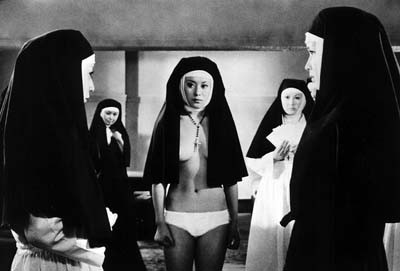
School of the Unholy Beast
In a searing flashback we find out that Hayumi’s mother, who became impregnated by the sinister (though not entirely unsympathetic) priest, was tortured and hung. Luckily one of the nun’s salvaged the baby and led her away from the convent. The flashback torture scene is pretty intense and includes the mother superior whipping her pregnant stomach, stepping on it, and hanging her up to die. Another torture scene scathingly indicts the church by having a nun “revealed” to be a heretic. The nun is first forced to drink a gallon of salt water, then an image of Christ is placed under her legs. If she soils it she is a witch. The scene stretches the inevitable moment with slow panning shots of the nuns earnestly waiting. The poor nun can not hold it in any longer and urinates onto Christ. She is then whipped. Droplets of blood fall into and mix with the urine!
Where classic Japanese exploitation cinema is concerned, Female Convict Scorpion proved an even bigger hit among both the converted and the skeptical. Undoubtedly it shows that the late 1960’s, early 1970’s period of Japanese exploitation cinema produced its share of innovative and challenging work, alongside one-dimensional (i.e. purely exploitative) fare (like the disappointing Wife to be Sacrificed). For those of you familiar with the work of Seijun Suzuki (disappointingly, as yet to be represented at Fantasia), Female Convict Scorpion is in this vein, with its strong female characters, striking camera angles and compositions, and baroque set pieces.
Fantasia 1999 showcased the works of Johnnie To and his MilkyWay production company. Fantasia has been a fan of To’s work since its inception, screening just about all his earlier films (as producer or director): The Odd One Dies, The Longest Nite, Too Many Ways to be Number One, The Heroic Trio, Beyond Hypothermia, and The Intruder. In 1999 they went a step further by inviting Johnnie To to Montreal to be part of the proceedings, which included 4 films: Expect the Unexpected, Lifeline, A Hero Never Dies, and Where a Good Man Goes; and being the centerpiece of a critical forum organised by Ciné-Asie on the state of current Hong Kong cinema (HK vs. Hollywood). So he was kept busy by the Fantasia conglomerate. But the experience proved worthwhile all-round. Fantasia has been trying to convince Hong Kong actor extraordinaire Lau Ching-Wan to come to Montreal for several years now, and he finally accepted for Fantasia 2000, apparently on the recommendation of Johnnie To! So clearly To enjoyed his experience at Fantasia 1999.
In Where a Good Man Goes Lau Ching-wan plays Cheung, a Triad leader released from a Macau prison. Cheung tries to get his old gang to pay him the 2 million dollars he claims they owe him, but they are in no financial position to repay him. The first half of the film has a nice edge, establishing Cheung’s wide mean streak and short temperature with more humor and warmth than usual for a Johnnie To film. Cheung lives in a hotel run by a feisty female owner, Suet (Ruby Wong), who eventually wins Ching-wan away from his former past. The second half becomes heart tugging, but works emotionally because of Ching-Wan’s winsome performance. Even the classic bad overweight cop is redeemed in the end. Suet tries to Cheung to give himself up. Cheung’s transformation to good guy is complete when he refrains from retaliating at the beating of a detective who clearly wants to incite him. The film then jumps forward three years, with Cheung walking out of prison again. He hails a cab, and the driver is the very same cop who beat him up. He offers Cheung a light and a free ride. Where a Good Man Goes is like an urban Shane, only with the gunslinger opting to stay and settle down with the woman homesteader. The film demonstrates an optimism that is atypical of To’s other directed films. The film may in fact be closer to To’s real sensibility than his darker films. I say this because in the forum on current Hong Kong cinema, To had an optimistic take on everything asked of him concerning the future of Hong Kong cinema (the seemingly shrinking marketplace and finances, loss of talent, Hollywood influence, etc.).
Another personable Fantasia invited guest in 1999 was the German independent director Jorg Buttgereit. Buttgereit, a Godzilla nut and authority, was clearly enjoying Montreal and Fantasia hospitality. Two key Buttgereit films were amongst the programming: Nekromantik, still the reigning über-necrophiliac film and Schramm, Buttgereit’s introspective anti-serial killer film. According to Buttgereit, his films de-glamorize death. They do this by stripping death of any life-affirming or spiritual element and reducing it to blood, skin, bones, and ashes; they are “materialist” horror films. Though sometimes punctuated by reflexive moments of humor, his films are marked by a dreary sense of oppression and fatality (grainy images, lethargic pacing, and understated acting). His aesthetic approach is in many regards antithetical to horror film formal or narrative convention. As Paul Anthony-Woods writes in his essential essay “Nihilist Cinema,” Buttgereit’s films have “no predictable build-ups of tension between scenes of relative calm and ghastliness, no sudden shocks or ‘false alarm’ jolts” (Rapid Eye 2, p. 57). Tall, blonde, and handsome, Buttgereit does not exactly look the part. And in fact in his two introductions and Q & A’s he came across as gentle and charming. He revealed that he was motivated to make Schramm because existing serial killer films never ventured far enough into the mind of a killer to the point where the hatred and violence is internalized and self-inflicted. Which is probably why the camera rarely leaves Schramm‘s unappealing apartment. Schramm is like a male version of Catherine Deneuve’s character in Repulsion, locking himself in his apartment and slowly festering in his own psychosis.
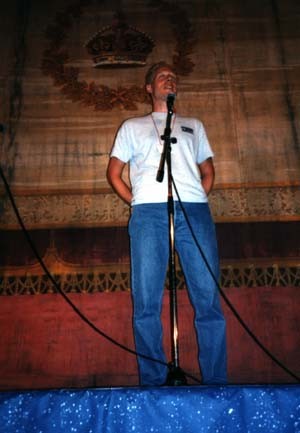
Buttgereit Introduces Schramm
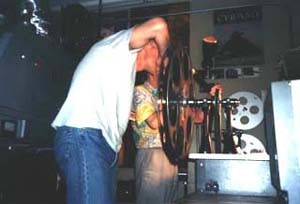
Buttgereit Examines Print in Booth
Two of the wilder guest appearances were the group representing the American film noir homage Night Train, and Rudy Ray Moore, in town with his 1975 blaxploitation cheapie Dolemite and Detroit 9000. Night Train had a large conglomerate in tow, including star John Voldstad, director Les Bernstein, the producer, and the woman who dubbed the screams (the names escape me). Her presence no doubt inspired the pre-film contest, where members from the audience came up to belt out their best scream in exchange for a cheap bottle of ‘Night Train’ wine. The moon must have been in a strange orbit on the night of the Night Train premiere, August 9. After the successful screening (and one of the best Q & A’s of the fest), the Night Train gang were in high spirits. For some inexplicable reason, we decided on a sleazy bar called Cleopatra as our watering hole. Cleopatra houses a conventional striptease bar on the first floor, and transvestite night-club on the top floor. Everyone had so much fun that evening that it became the regular alternative (to the Luba Bar) post-film hangout. Exactly why I’m not sure. Maybe because it is so removed from the world of film (or is it?), that it became an easy place to let it all hang out and forget about all the pressures that go with organizing a major festival (it may appear all fun, but there is tons of work involved in a major film festival). And let it hang out is precisely what happened that night. It was a slow night. There were only a few non-Fantasia patrons, and even fewer dancers. After a few too many beers and a few dares, members of our esteemed coterie (including one guest) took to the stage to strut their stuff. Showgirls (and boys) watch out! It was quite a memorable night. We did find it strange however, that after providing all the entertainment we were not even offered a free round of beers!
On August 14 Rudy Ray Moore performed a live comedy routine before the double-bill of Dolemite and Detroit 9000. One could sense that Moore was a little apprehensive about walking in front of a sell-out Fantasia crowd (900) to do a saucy, no-holds-barred comedy routine. Dressed in traditional African dress, Moore strutted down the aisles to large applause and funky music. After getting rounds of laughter from his opening jokes Moore appeared to relax and gain increasing confidence. He assumed the persona of Doctor Sex, PhD (Pretty Hard Dick), and performed a rhyming alphabet toast (A is for assholes, etc.) just to show those young rappers and hip-hopsters where it all began. In fact his routine went considerably longer than the 20 minutes I was told he would perform. Granted his X-rated, sexist humor was not exactly original – Red Foxx must have been rolling in his grave – but it seemed to go over well with the Montreal crowd. As the show ended he walked down the aisles, then stopped and turned to address the audience: “I meant no harm or offense to anyone tonight, but if I did, from the bottom of my heart…I don’t give a fuck.” He turned and walked toward the theatre lobby (where he had a table set up to hawk Rudy Ray Moore merchandise (videos, posters, photos, audiotapes, a Rudy Ray Moore backscratcher, etc.). Dolemite was the first film to follow. I wasn’t expecting much, but no level of expectation could make one lose sight of the film’s torrent of flaws: awful acting, shots with visible boom, ludicrously tepid sex scenes, clumsy fight choreography, and, oh those pastel colors! But it did contain one exemplary moment of toasting (art of jive talking), when Dolemite holds court in a parking lot, and bears that irresistible line, “Dolemite’s my name, fucking up mothafuckers is my game!” After Dolemite I thought it might be too painful to stay for Detroit 9000, which I heard was considerably worse. So I bought my autographed Dolemite backscratcher and scampered over to Luba’s for a beer.
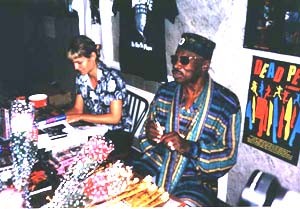
R.R. Moore Hawking His Wares
Once over-represented at Fantasia, in 1999 Jackie Chan fans had to be content with City Hunter, directed by everyone’s favorite Hong Kong whipping boy, Wong Jing. Jackie Chan plays Ryu Saeba, a womanizing detective who, in the end, is neither lecherous nor vile enough to match the film’s broad, slapstick comedy. Hence the sex stuff, of which there is a lot, comes across as kid stuff compared to the non-sex adult humor. Even Harpo Marx had more of an edge to his sexual outbursts. For example, the film ends with Jackie turning down an offer to marry into a rich Japanese family (and the girl is gorgeous) because he can not give up bachelorhood. But the final (pre-outakes) cartoony scene sees Jackie in a swimming pool surrounded by a bevy of beautiful women. I guess it was a question of Chan the Star not wanting to come across as Chan the Pervert. (though a Hong Kong person I recently met in London told me that Chan, married, has been mired in a controversy recently by having a child with another woman). There are some good moments in City Hunter, including an amazing extended skateboard chase through city streets, and the funniest scene, the video game environment, where Jackie and his nemesis become characters from a video game, and are filmed as video game figures. But too many fight scenes are lazily choreographed with fast motion, frenetic cutting, and exaggerated sound effects. But the award for the campiest film of the festival, hands down, goes to The Mighty Peking Man (1977). It helps that the film is a rip-off of Dino De Laurentis’ King Kong (1976), no slouch itself in the camp territory. The slow motion scene of the gorgeous, loin-clothed ‘Jane’ amorously twirling a seriously tranquilized jaguar must be seen to be believed.
Which leads naturally to this year’s union of Fantasia and Just For Laughs. It may seem like an odd mix, but comedy has always had a place in Fantasia (Jackie Chan, Stephen Chow, Troma, those wacky Spanish films, Fatal Frames [perhaps the unintentional comedy classic of all time], Sex and Zen, etc. I’ve never been a big fan of Stephen Chow’s nonsense comedy, but King of Comedy was a film I quite enjoyed, and contained an hilarious comic set-piece in an outdoor shower that involved a hole in the wall, some soap, and private parts. Korea’s black comedy The Quiet Family also proved a fan favorite, with its mixture of sitcom scenario and Hitchcockian black humor. When the first guest at a family run hotel business unexpectedly dies overnight, the domino principle takes full effect as the family’s attempt to cover the death snowballs into a seemingly unstoppable run of odd deaths and murders. Though it looses steam after about three-quarters of the way, the film is stylish enough to make it an enjoyable 100 minutes.
The most inventive and resonant comedy of the festival was the Scottish film The Acid House. The film is composed of three stories dealing with different aspects of Edinburgh social underclass. Though class is not marked on the film’s forehead, it simmers throughout the episodes. The film plays as a comedy all the way through, but goes full tilt with the final episode, which may be both the out and out funniest, yet weakest of the three. The first concerns a hapless 20-something loser named Boab Coyle, stuck in a dead-end job, who has a day from hell. Things start bad and get worse. He gets kicked off the football squad, dumped by his girlfriend, and then forced to move out by his parents, who are mired in their own mid-life crisis and want privacy so they can rekindle their sex life (through hilarious kinky sex). He loses his job and then goes to his local bar, where he meets, of all people, a less than amicable God. This God, who looks like your regular barfly, has just about had it with the human race. He turns our sad sack hero into a fly, which leads to some great requisite fly POV shots. Coyle makes the best of his newfound freedom by exacting revenge on all those who have slighted him. The second shifts the tempo and mood to kitchen sink realism, with a story about a spineless Johnny who is forced to marry a pregnant Catriona, and then suffer the indignities of being a cuckold when his wife flagrantly beds a crass lowlife named Larry. The story contains a shocker of a narrative twist, when what seemed like a flashback turns out to be a linear repetition of hugely ironic proportion. The third story changes tempo again to madcap lunacy. An acid freak named Coco gets zapped by an electrical storm right into the womb of a middle-class woman, Jenny, just about to give birth. For the remaining moments we are treated to some hilarious incongruity comedy, as Coco’s strung-out adult mind is trapped in the body of a newborn.
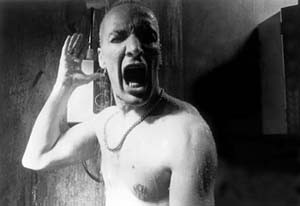
Acid House
The most frustrating moments at Fantasia were watching two stunning films, The Eternal and Heaven, that have been handled with the delicacy of a two-year old by the respective distributors, Trimark and Miramax. In both cases the films, too original in design and sensibility to be marketed in any straightforward way, will be shamelessly bypassed for theatrical and released straight to video. With The Eternal (a.k.a. The Trance), one could see the damage already done to the languid sensuousness of the film, with the interjection of two secondary characters near the end for purposes of ‘action’. One could also sense the resigned, melancholic frustration in the face and voice of director Michael Almereyda, in attendance to introduce the film. In the case of Scott Reynold’s (The Ugly) Heaven, there are just too many ideas bursting out of a criss-crossing, non-linear narrative structure. Miramax simply did not know what to do with the film. This is evident from the Miramax trailer I saw, where the film is made out to be a conventional action thriller it clearly is not.
Fantasia 2000 looks as promising as ever. Though there are only 6 Hong Kong films, except for one, 2000 AD, they all come with an impressive pedigree. Bullets Over Summer (1999), and Juliet in Love (both by Wilson Yip, 2000), Johnnie To’s The Mission (which won for best film at this year’s Hong Kong Film Awards), and Running Out of Time (1999), and Ringo Lam’s Victim (2000). And, of course, Montreal waits with abated breath for the appearance of actor extraordinaire Lau Ching-Wan, who stars in Victim and Running Out of Time. One of my favorite horror films in recent years, Wisdom of the Crocodiles, finally gets picked up at Fantasia. I saw this in its initial release in London. Some of the London press thought the film too ‘arty’, a label I often find puzzling. In this case, the nature of the character and film’s theme is well suited to Hong Kong director Po Chih Leong’s precious style. The central character, played by Jude Law, is a modern day vampire (though the word vampire is never mentioned) with an unusual twist on the vampire myth. Law can only vampirize a person after gaining their undivided love. His body can not consume blood that isn’t fully given over to him. Like Udo Kier in Blood of Dracula, who can only drink virgin (or ‘wirgin’) blood, Law vomits when drinking some of Elina Lowensohn’s blood because there still remains, in her, remnants of remorse and resentment. In order to attain a woman’s whole love, he must act the perfect prince, and in fact is a woman’s dream: attractive, rich, caring, charming, intelligent, and mysterious. Hence the mannered style, which some critics have labelled ‘arty’ or ‘pretentious’, is fully justified by Law’s character and what he must become to survive. I will not give up any more of the plot, but keep in mind the thematic recurrence of ‘salvation’.
It is nice to see Fantasia bring to fruition Lucio Fulci’s gothic zombie trilogy. In year’s past Fantasia has screened The Beyond and The House by the Cemetery. This year they conclude with the first of the series, The Gates of Hell (a.k.a. The City of the Living Dead). The late Fulci is best known for his uncompromising, explicit use of violence in both the gothic-supernatural form and the psycho-thriller-giallo genre. In pure Italian style, Fulci’s assets are not in the area of plot construction or character development, but in morbidly guiding the audience to experience the over-the-top deaths of his protagonists. The latter often accomplished with a combination of bold zoom shots, extreme close-ups, staccato editing and hell-bent soundtracks. The films from the period of 1979 to 1982 are Fulci’s best because they place the moments of excessive violence within genuinely creepy, gothic settings. By using the same core creative crew, Fulci has fashioned a compelling triptych that is one of the most visually and thematically unified of horror trilogies, and a landmark of contemporary horror cinema. If forced to judge the three films I would rank The Gates of Hell and House by the Cemetery behind The Beyond (The Beyond Reviewed), because they lack the latter’s pop-metaphysics and sustained treatment of evil. But there is very little to choose between The Gates of Hell and House by the Cemetery. The film opens with a priest hanging himself. The townsfolk lament that “ever since Father Thomas hung himself, the town hasn’t been the same.” And Father hasn’t been the same either, as he now roams the earth heading the army of the undead on their earthly ravages and using his Svengali-like powers to hypnotize people into bleeding out of their facial orifices and vomiting their innards. The bleeding orifices are probably Fulci’s twisted take on Roman Catholic imagery, specifically stigmata, a condition where marks or bleeding occur on a person in a state of religious hysteria or ecstasy. With imagery like this, plus the unflinching electric drill through the head scene (John Morghen’s head of course!), to those of you for whom these things matter you know who you are The Gates of Hell outdoes the subsequent two films on a gore quotient. Unlike the zombies in The Beyond, some of the undead in The Gates of Hell are fast moving, strong, and have a penchant for attacking from behind and burrowing brains out from the back of skulls. They may be quick, but Fulci’s zombies would loose a foot race with the speedy Gonzales zombies from Umberto Lenzi’s entertaining City of the Walking Dead, also playing at Fantasia 2000. Get your stopwatch ready and watch them both!
As of this writing, I can say that the midnight sold-out screening of The Gates of Hell at Fantasia 2000 was an amazing rush. I sat in the first row, not my usual preferential seat. But it seemed the best place to be. The audience reacted at all the right moments, and I felt the collective energy like an electric surge rushing up to the front of the screen. Even with a spotty 35mm print, Fulci’s visionary, dime store take on Christian apocalyptic imagery still holds (holy) water compared to past and present contemporary purveyors of horror. The narrative is non-existent (the protagonists must get to Father Thomas’ tomb before All Saint’s Day, that’s it), script laughable, and acting lazy (by Christopher George, not Catriona MacColl), but Sergio Salvati’s cinematography and lighting, and Fabio Frizzi’s music complement each other like two sinister eyes. Fulci is scornful of narrative logic. Which gives the film a flow and stutter pacing between exposition and atmosphere. It may hurt his other films (Cat in the Brain, for example), but in The Gates of Hell (and the zombie trilogy) the atmosphere of the non-exposition/or non-dialogue scenes (actually most of the scenes with the minor characters, up until the climax), are so powerful they have a residual effect lasting into the intervening scenes (like Morghen wandering around the country house grounds and the wonderfully edited scenes of the three men in the bar).
Other much anticipated films this year are: Gemini, the latest from Shinya Tsukomoto, who gave us the brilliant Bullet Ballet last year; To’s award winning The Mission; the film which has apparently caused compulsive walk-outs during its disturbing conclusion at festivals everywhere, Takashi Miike’s Audition, Ringo Lam’s Victim; the hugely popular Bollywood extravaganza, Muthu; Hideo Nakata’s Chaos, the Donald Cammell reconstructed/director’s cut of Wild Side, and the American indie Ricky 6. Stay tuned later for my thoughts on these and more (how much later is anybody’s guess!).



